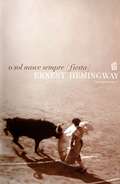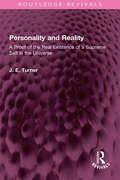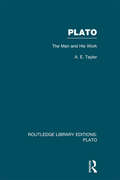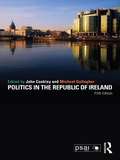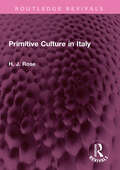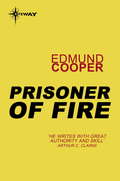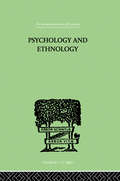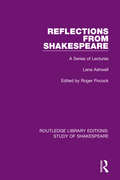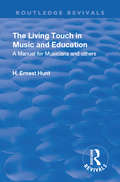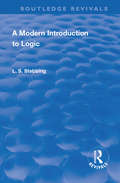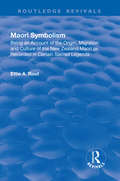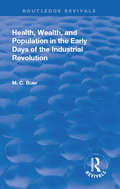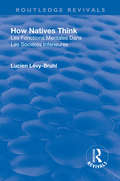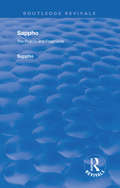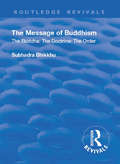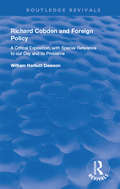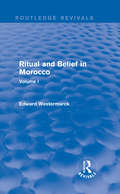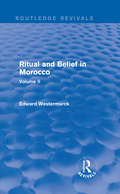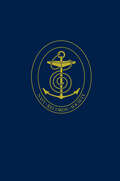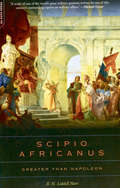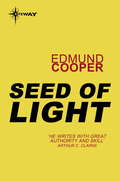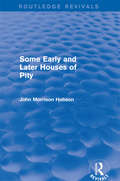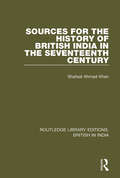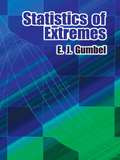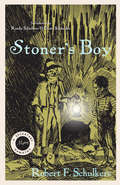- Table View
- List View
Personality and Reality: A Proof of the Real Existence of a Supreme Self in the Universe (Routledge Revivals)
by J. E. TurnerFirst published in 1926, Personality and Reality is the analysis of the place and function of mind and God. The author argues that the conception of a supreme Self is required for the interpretation of the Universe, just like the requirement of the system of space and time; and that both conceptions are established by necessities. This book will be of interest to students of philosophy, religion, literature and science.
Plato: The Man And His Work (Routledge Library Editions: Plato)
by A.E. TaylorThis book provides an introduction to Plato’s work that gives a clear statement of what Plato has to say about the problems of thought and life. In particular, it tells the reader just what Plato says, and makes no attempt to force a system on the Platonic text or to trim Plato’s works to suit contemporary philosophical tastes. The author also gives an account that has historical fidelity - we cannot really understand the Republic or the Gorgias if we forget that the Athens of the conversations is meant to be the Athens of Nicias or Cleon, not the very different Athens of Plato’s own manhood. To understand Plato’s thought we must see it in the right historical perspective.
Politics in the Republic of Ireland
by Michael Gallagher John CoakleyPolitics in the Republic of Ireland is now available in a fully revised fifth edition. Building on the success of the previous four editions, it continues to provide an authoritative introduction to all aspects of politics in the Republic of Ireland. Written by some of the foremost experts on Irish politics, it explains, analyzes and interprets the background to Irish government and contemporary political processes. Bringing students up to date with the very latest developments, Coakley and Gallagher combine real substance with a highly readable style, providing an accessible textbook that meets the needs of all those who are interested in knowing how politics and government operate in Ireland.
Primitive Culture in Italy (Routledge Revivals)
by H. J. RoseFirst published in 1926, Primitive Culture in Italy intends to determine to what extent there survived, in the ancient civilization with which it deals, any characteristic features of savage life and thought. The primitive man provides an ideal beginning to study the long upward progress of humanity. This book is not for the specialist, but for the general reader who wishes to know something of the beginnings of a great and notable civilization, the effects of which are still to be seen in our modern culture.
Prisoner of Fire
by Edmund CooperVanessa Smith looked like any normal seventeen year old girl. But Vanessa wasn't normal at all.She possessed extraordinary telepathic powers - and in the 1990s telepathy was the ultimate weapon in psychological warfare. Vanessa, along with other gifted children, was virtually a prisoner at Random Hill Residential School, developing her abilities for Government exploitation.So when she escaped, Vanessa became a political embarrassment. Questions were asked by the Opposition. It was vital for the Prime Minister, the ruthlessly dictatorial Sir Joseph Humbolt, that everything that marked Vanessa's existence should be erased. And orders were given that she should be hunted down - using telepaths like herself - and destroyed.
Psychology and Ethnology (International Library Of Psychology Ser. #Vol. 36)
by W H RiversFirst published in 1999. Routledge is an imprint of Taylor & Francis, an informa company.
Reflections From Shakespeare: A Series of Lectures (Routledge Library Editions: Study of Shakespeare)
by Lena AshwellOriginally published in 1926, this title was edited from a series of lectures the author gave to raise money for her theatre group the Lena Ashwell Players. Through her work as a producer the author gained a deeper knowledge of a number of Shakespeare’s plays and in order to support her work gave a number of lectures on "Women in Shakespeare". This title was perhaps the first book by a woman of the profession, appealing to the public for a larger and deeper understanding of Shakespeare: the man, his life, and that group of tragedies in which he fathomed Hell, then scaled the Heavens.
Revival: A Manual for Musicians and Others (Routledge Revivals)
by H. Ernest HuntThese chapters contain the subject matter of a year’s course of thirty lectures which have now, for several years past, been given in connection with the Training School for Music Teachers, London, W. I.
Revival: A Modern Introduction to Logic (Routledge Revivals)
by Lizzie Susan StebbingAs the author of this volume states, "the science of logic does not stand still." This book was intended to cover the advances made in the study of logic in the first half of the nineteenth century, during which time the author felt there to have been greater advances made than in the whole of the preceding period from the time of Aristotle. Advances which, in her eyes, were not present in contemporary text books. As such, this book offers a valuable insight into the progress of the subject, tracing this frenetic period in its development with a first-hand awareness of its documentary value.
Revival: An Account of the Origin, Migration and Culture of the New Zealand Maori (Routledge Revivals)
by Ettie A. Rout‘Maori Symbolism’ is a story of a great race as told in their own Sacred Legends. And it is even more than this. It is an accurate record of the inner meaning of Life Symbolism on which the civilization of the Dark-Whites all over the world is founded. That symbolism stands for Cultivation – of the race, of the body and of the land. The numerous illustrations are to be regarded as documents supporting the evidence reported in the text. Some of this is of startling interest, as for insurance that concerning the casting of ancient statues and megaliths from molten lava. The Sacred Legends concerning the origin and migration of the New Zealand Maori are reported at some length, and the evidence given throws fresh light on the important ‘Diffusion’ controversy. Maori land cultivation is shown to have been far in advance of European. Maori cultivation of the body, expressed in native dances, is demonstrated to be an ordered system of physical education, designed to improve and preserve the fittest. Maori race culture is exhibited as based on a lofty code of social and sexual ethics. Maori religion and philosophy, as expressed in symbolic decoration and writing, are for the first time truthfully explained and interpreted.
Revival: Health, Wealth, and Population in the early days of the Industrial Revolution (Routledge Revivals)
by Mabel Craven BuerThis book provides a comprehensive over view of eighteenth-century British medical reform, but as an economic historian, Buer considered the effect of diseases and medical intervention on population growth, not on medical ideas. Other optimistic views of the century either focused, like Buer, on the 'standard of living debate' or a related debate about the role (if any) of hospitals and public health measures in reducing mortality during the industrial revolution, giving only pasing attention to disease theory.
Revival: How Natives Think (Routledge Revivals)
by Lucien Lévy-BruhlLevy-Bruhl speculates about what he posited as the two basic mind-sets of mankind; "primitive" and "Western." The primitive mind does not differentiate the supernatural from reality, but rather uses "mystical participation" to manipulate the world. Moreover, the primitive mind doesn't address contradictions. The Western mind, by contrast, uses speculation and logic. ‘How Natives Think’ IS an accurate and valuable contribution to anthropology.
Revival: Sappho - Poems and Fragments (Routledge Revivals)
by SapphoThe object of this book is to provide with a popular and a comprehensive edition of Sappho, containing all that is so far known of her unique personality and her incompatible poemsLittle remains today of the writings of the archaic Greek poet Sappho (fl. late 7th and early 6th centuries B.C.E.), whose work is said to have filled nine papyrus rolls in the great library at Alexandria some 500 years after her death. The surviving texts consist of a lamentably small and fragmented body of lyric poetry--among them, poems of invocation, desire, spite, celebration, resignation, and remembrance--that nevertheless enables us to hear the living voice of the poet Plato called the tenth Muse. Sappho is rated as the supreme poetess and is regarded in the same vein as Shakespeare and Homer the supreme poets.
Revival: The Doctrine; The Order (classic Reprint) (Routledge Revivals)
by Subhadra BhikkhuThe Message of Buddhism is an adaptation of the Buddhist Catechism of the late Subhadra Bhikkhu which was first published in 1888. The eighth and last edition of the Catechism was translated into English by C. T. Strauss, and was published by the Maha-Bodhi Society in 1908.
Richard Cobden and Foreign Policy: A Critical Exposition with Special Reference to our Day and Its Problems (Routledge Revivals)
by William DawsonPublished in 1926: This book has been written as a tribute to a great Englishman and with the hope that it may throw light upon some of the difficult problems which to-day confront British statesmanship in the domain of freignrelations and policy.
Ritual and Belief in Morocco: Vol. I (Routledge Revivals)
by Edward WestermarckBetween the years of 1898 and 1926, Edward Westermarck spent a total of seven years in Morocco, visiting towns and tribes in different parts of the country, meeting local people and learning about their language and culture; his findings are noted in this two-volume set, first published in 1926. Alongside extensive reference material, including Westermarck’s system of transliteration and a comprehensive list of the tribes and districts mentioned in the text, the chapters discuss such areas as the influences on and relationship between religion and magic in Morocco, the origins of beliefs and practices, curses and witchcraft. This is the first volume of two dealing with the same subject, and will fascinate any student or researcher of anthropology with an interest in the history of ritual, culture and religion in Morocco.
Ritual and Belief in Morocco: Vol. II (Routledge Revivals)
by Edward WestermarckBetween the years of 1898 and 1926, Edward Westermarck spent a total of seven years in Morocco, visiting towns and tribes in different parts of the country, meeting local people and learning about their language and culture; his findings are noted in this two-volume set, first published in 1926. The first volume contains extensive reference material, including Westermarck’s system of transliteration and a comprehensive list of the tribes and districts mentioned in the text. The chapters in this, the second volume, explore such areas as the rites and beliefs connected with the Islamic calendar, agriculture, and childbirth. This title will fascinate any student or researcher of anthropology with an interest in the history of ritual, culture and religion in Morocco.
Samuel Pepys Naval Minutes
by J. R. TannerOver the years the NRS has published various volumes relating to Samuel Pepys including the catalogues of his letters.His Naval Minutes mainly cover the period from 1680-1696. As the Naval Minutes are a series of random notes made by Pepys in connection with his proposed History of the Royal Navy, as well as notes and memoranda of his thoughts on naval affairs ranging from shipbuilding and navigation to manning and the hazards of going to sea, as well as acerbic comments on the admiralty commissioners of 1679-1683, they provide invaluable information about the navy.The volume includes Pepys’s famous dictum that Englishmen love their bellies. It also shows Pepys’s relationship with the Duke of York, and how much the Duke was still consulted over naval affairs, even though he had resigned his post as Lord High Admiral in 1673, because of his Catholicism.
Scipio Africanus: Greater Than Napoleon
by B. H. Liddell HartScipio Africanus (236-183 b. c. ) was one of the most exciting and dynamic leaders in history. As commander, he never lost a battle. Yet it is his adversary, Hannibal, who has lived on in public memory. As B. H. Liddell Hart writes,"Scipio's battles are richer in stratagems and ruses--many still feasible today--than those of any other commander in history. " Any military enthusiast or historian will find this to be an absorbing, gripping portrait.
Seed of Light
by Edmund CooperTEN MEN AND WOMEN ESCAPED IN THE STARSHIP - THE ONLY HOME THEY WOUKD KNOW FOR GENERATIONS - THE SEED FROM WHICH THEY WOULD BUILD A NEW RACE. The Solarian was a hundred metres high and, at its broadest point, twenty metres in diameter. It was designed to carry an initial crew of ten people - five men and five women - with provisions for subsequent children. Yet in that vast hull every cubic metre of space was indispensable, for the ship was a self-contained world, required to support human life independently for centuries. No member of the crew, male or female, could regard themselves as a separate entity, an individual personality. But each person was a part of a total life-unit, a dedicated nucleus that might one day expand into a tribe; that might, phoenixlike, bring forth a new human race.
Some Early and Later Houses of Pity (Routledge Revivals)
by John Morrison HobsonFrom around the eleventh century until the Reformation, a close connection between the Church and hospitals was formed as they became a refuge for the ill, ostracised and poor. First published in 1926, John Morrison Hobson presents a fascinating survey of the hospitals and almshouses found throughout medieval England. Full of photographs and illustrations, Hobson surveys the almshouses by geographical location and provides a social and historical context for each. This practical and interesting study will be of use to students and academics with an interest in English hospitals and almshouses, their relationship to the Church, and English social history more generally.
Sources for the History of British India in the Seventeenth Century (Routledge Library Editions: British in India #22)
by Shafaat Ahmad KhanThis book, first published in 1926, is neither a catalogue of libraries and record offices, no is it a selection of transcripts from the English and Indian archives. The object of the undertaking is two-fold: in the first place, it looks at supplying a critical analysis of essential data for the study of seventeenth-century British India; in the second place, it looks at bringing within one purview all the materials lying scattered in various record offices. Every important document has been subjected to a close and careful scrutiny, and references have been given to printed works that throw further light on the subject.
Statistics of Extremes
by E. J. GumbelUniversally acknowledged as the classic text about statistics of extremes, this volume is geared toward use by statisticians and statistically minded scientists and engineers. It employs elementary terms to explain applications, favors graphical procedures over calculations, and presents simple generalizations as exercises -- all of which contribute to its value for students. Starting with definitions of its aims and tools, the text proceeds to discussions of order statistics and their exceedances, exact distribution of extremes, and analytical study of extremes. Additional topics include the first asymptotic distribution; uses of the first, second, and third asymptotes; and the range. 1958 edition. 44 tables. 97 graphs.
Stoner's Boy: A Seckatary Hawkins Mystery (The Seckatary Hawkins Mysteries)
by Robert F. Schulkers“Scholars, teachers, and general readers of To Kill a Mockingbird will find Stoner’s Boy and The Gray Ghost of real interest.” —George Ella Lyon, formerKentucky poet laureate and author of Back to the Light: PoemsMr. Stoner is bad, and it seems his son is turning out just the same. Masked and dressed all in gray, Stoner’s Boy moves like a ghost up and down the river, stealing and causing mischief. Seckatary Hawkins and his club have crossed this dangerous lad, and (to make matters worse) Briggen and the Pelham gang across the river won’t leave the ruthless thief alone: They know that he’s hidden his treasure hoard somewhere in his cliff cave lair, and they’re dead set on having it for themselves. Still, it doesn't seem that anyone can stand up to this clever foe—except maybe another newcomer in town, sharpshooter Robby Hood, who is the only person that Stoner’s Boy seems to fear.Before Nancy Drew and the Hardy Boys, Seckatary Hawkins and his friends from the Fair and Square Club were solving mysteries and thrilling readers with tales of adventure, loyalty, and courage. One of the biggest fans of the series was author Harper Lee, and Stoner’s Boy makes a prominent appearance in her masterpiece To Kill a Mockingbird. Now, the tales of the Fair and Square Club’s encounters with the river renegade known as the Gray Ghost are back in print and ready to ignite the imaginations of devoted fans and new readers of all ages.“Think Our Gang meets Treasure Island along a Kentucky riverbank . . . The wholesome stories espouse morals and tolerance.” —Cincinnati Enquirer
